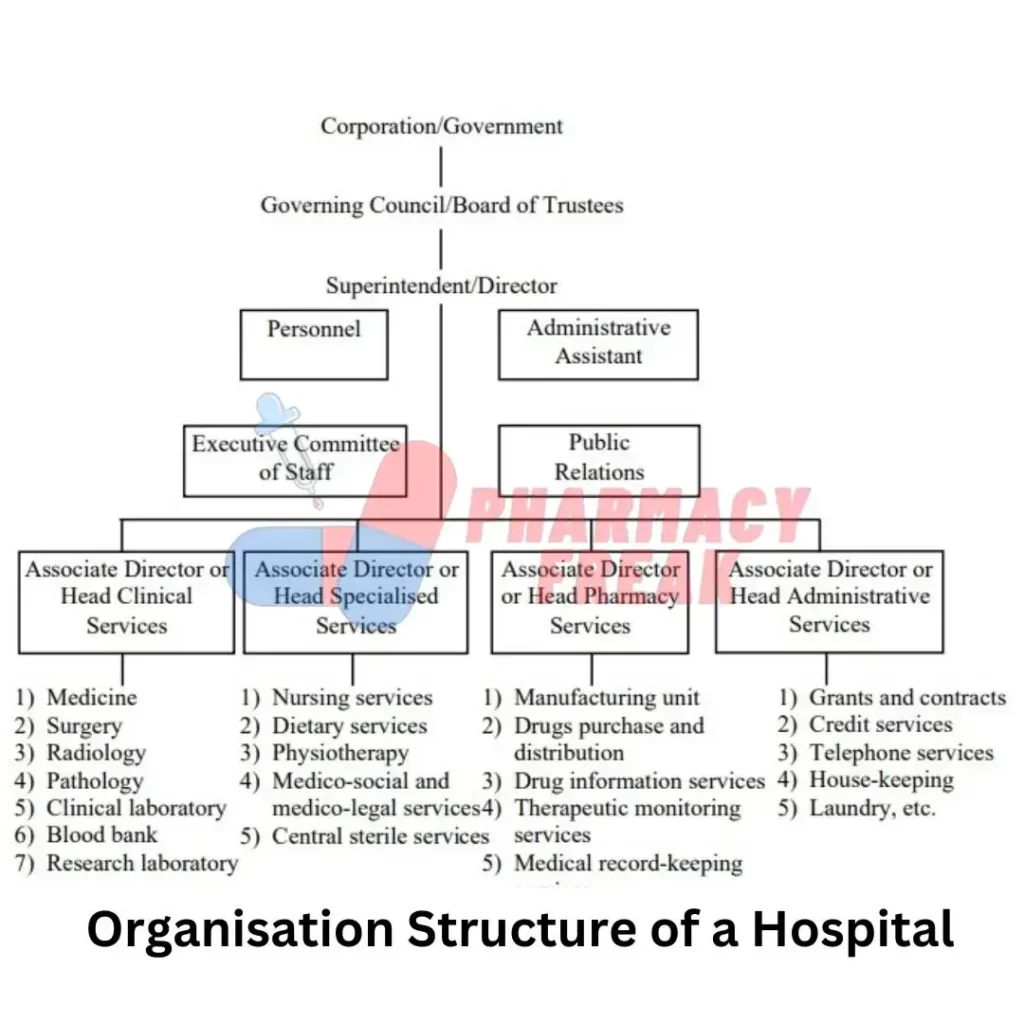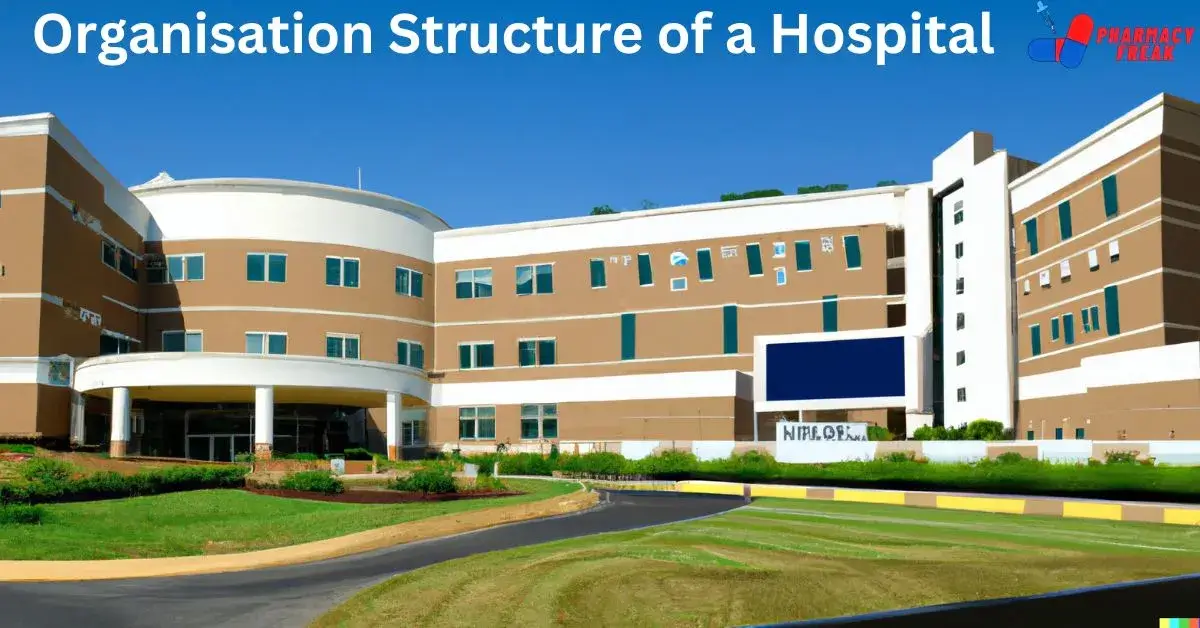The organisation of modern-day hospitals is a complex network of committees, departments, personnel, and services. The hospitals are not only caring, people-oriented institutions, but also many -faceted, high -tech business. They operate like other large businesses constantly concerned about their bottom line, and have a hierarchy of personnel and channels of authority. However, the number of administrative personnel depends on the hospital size.
The organisation of hospitals includes the following:
- 1) Administrative staff
- 2) Medical staff
- 3) Associated medical services
- 4) Supportive paramedical services and staff

Administrative Staff
The administrative services of a hospital are controlled by a chief executive officer or president. They have day -to-day responsibility for handling all the hospital businesses. He or she is the highest-ranking administrative officer who manages all the administrative departments associated with financial operations, public relations, and personnel. In many large hospitals, a chief operating officer manages the activities of certain departments, and a chief financial officer guides the financial activities of the hospital. These key administrative officers are corporate vice presidents of the hospital. The huge number of employees and the extensive collection of individual skills needed to staff a hospital calls for personnel or human resources department with specialised labour expertise. This department is also headed by a vice president for human resources. Nursing is a great component of the hospital’s service operations; thus, larger facilities also have a chief nursing executive at the vice president level.
Medical Staffs
Each hospital should have a medical staff with the aim to provide medical care to the patients as per the ethical conduct and professional practices of their membership. The structure of medical staff is different in every hospital. Following are the divisions of medical staff in large hospitals:
- 1) Residential Medical Staff: These staff members remain available for 24 hours to attend the patients. They are also responsible for the organisational and administrative duties.
- 2) Associate Medical Staff: These staff members include the physicians allotted to different services similar to the members of the active medical staff. These can be progressive as the residential medical staff.
- 3) Consulting Medical Staff: These staff members include medical physicians of known professional ability.
- 4) Honorary Medical Staff: These staff members are like part-time consulting medical staff. These members are retired physicians or physicians possessing a clinic and providing nominal facilities to the hospital
Associated Medical Services
Associated medical services include the following:
Medicine Division
Following are the departments of the medical division:
- i) Internal medicine
- ii) Cardiology
- iii) Gastroenterology
- iv) Nephrology
- v) Pulmonary diseases
- vi) Psychiatry and neurology
- vii) Infectious diseases
- viii)Allergy
- ix) Skin and venereal diseases
- x) Endocrinology
- xi) Geriatrics
- xii) Immunology
- xiii) Paediatrics
Surgery Division
Following are the departments of surgery division:
- i) General surgery
- ii) Obstetrics and gynaecology
- iii) Orthopaedic surgery
- iv) Ophthalmology
- v) Otolaryngology
- vi) Dental and oral surgery
- vii) Nephrology
- viii)Neurological surgery
- ix) Cardiothoracic surgery
- x) Plastic surgery
- xi) Anaesthetics
Radiology
It is the branch of medicine that deals with the diagnostic and therapeutic application of radiant energy in the form of roentgen X -rays and radium. The radiology department is headed by a M.D., who provides services on receiving a written order by a member of medical staff. Radium or sealed radioactive sources can be therapeutically used by those physicians who have been given permission in consultation with the radiologist and/or radiation safety committee. Radioactive substances should be handled by appropriately trained and experienced personnel. This department includes physicians trained as radiologists, physicists, technicians, radiotherapists, isotope -pharmacists, nurses, assistants, and secretarial persons. Modern radiology departments also have facilities of sonography, Computer-aided Tomography (CT) scanning, MRI (Magnetic Resonance Image), etc.
Pathology and Clinical Biochemistry Services
These services provide the facility of collecting samples of blood, urine, sputum, faeces, etc., in order to detect the presence of pathogenic infection or abnormality in biochemical parameters such as sugar, urea, etc. The related processes are done as per the instructions of the physician, surgeon, etc. A medical person qualified in the branch of pathology or medicine is appointed as the head of these services.
Blood Bank
This service provides facility of collecting, processing, and supplying blood and its products (blood plasma, etc.). A blood bank is a store or a bank of blood and its components collected (from blood donations), stored and preserved to be used later in blood transfusion.
Supportive Paramedical Services and Staff
Supportive paramedical services and staff comprises of the following:
Nursing Services
The nursing team comprises of workers with variable degrees of skill in nursing and are directed by a professional nurse. This team replaces the single nurse who has done everything for the patient. Following are the main assumptions about the nursing care which helps for the better healthcare.
These were started by National League of Nursing in the U.S.A. in 1964:
- i) Nursing care includes health promotion, care and prevention of disease, rehabilitation, teaching and counselling, emotional support, and treatment of disease.
- ii) It is an essential part of the healthcare system and is performed in combination with related medical, educational, and welfare facilities.
- iii) The nursing team should respect individuality, dignity, and rights of every person irrespective of race, colour, breed, origin, and social and economic status.
Dietary Services
Food service plays an important role in hospitals. This is also a therapeutic measure directly related to scientifically-prepared nutritious diet meant for certain diseases. These services impose on the clinical care of the patient.
Following are the functions:
- Plans menu for general or special diet for patients and employees
- Selects and purchases food
- Maintains relationship with food vendor
- Receives and stores food
- Prepares and distributes food
- Maintains cleanliness and safety in the department
- Trains and supervises the staff
- Educates nations on dietary habits along with the medical or nursing staff
- Conducts research programs in teaching hospitals.
Medical-Social Service Department
This department serves as a link between the hospital and the patient and his/her relatives. The qualified social worker is a discipline who focuses on the social aspects of the patient and his/her family. The worker gives information regarding the medical and social study of suitable patients, and their home environmental particulars.
Central Sterile Services
The main function of the Central Sterile Services Department (CSSD) is to give sterile items, linens, and equipment to wards and OT’s. The department sterilises the reusable equipment and linens received from various wards. The department exchanges items as per the need. The linens are sent for washing to the laundry either directly or via CSSD, and the washed linens are then sent to CSSD for sterilisation. These sterilised items are then issued to the wards and OT’s whenever they demand for.
Medical or Patient Treatment Records
These are the systematic documentation of a patient’s medical history and care. Medical record is a physical folder for each individual patient as well as an information body that contains the complete history of patient’s health.
Drug Information Services or Centre
The aim of these services or centre is to document drugs by extracting information about them. Drug information is the information on physical, chemical, biological and health care sciences collected either in written forms (i.e., books, journals, periodicals, etc.) or conveyed by oral communication or by electronic devices.
Drug Distribution System
Every hospital use drugs and therapeutic substances in in-patient and out -patient departments. Bigger the institution, bigger is the problem of procurement and distribution of drugs.
The following two types of drug distribution system exist in hospitals:
- i) Drugs are distributed to indoor patients, operation theatres, X-ray, and other specified departments.
- ii) Drugs are distributed to outdoor patients (i.e., who are not admitted).
Two more drug distribution types are:
- i) Dispensing of narcotics and other controlled substances
- ii) Distribution and dispensing of ancillary substances and articles.
Related Links

I am a Registered Pharmacist under the Pharmacy Act, 1948, and the founder of PharmacyFreak.com. I hold a Bachelor of Pharmacy degree from Rungta College of Pharmaceutical Science and Research. With a strong academic foundation and practical knowledge, I am committed to providing accurate, easy-to-understand content to support pharmacy students and professionals. My aim is to make complex pharmaceutical concepts accessible and useful for real-world application.
Mail- Sachin@pharmacyfreak.com
